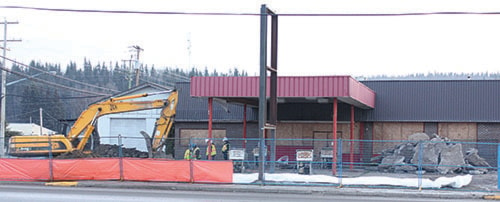Excavation has revealed contamination which may cost the District of Vanderhoof more to reclaim the old Kwik Save.
How much more is unknown as the amount of contamination is yet to be measured.
“The four tanks are in relatively good condition which was a surprise because we have hot soils which can be difficult on metal objects,” said Paul Carver, Director of Operations. “There should have been some contortions, which there wasn’t, but we think what happened is there was spillage over the years combined with possible leakage from previous tanks.”
NAPP Enterprises Limited, (the same company who did the expert demolition of the old provincial building) has removed the asphalt, fuel tanks and all associated piping. They found a large concrete pad about six to eight inches thick nobody knew existed, but once lifted, the contamination was found in varying degrees in the material above and surrounding the tanks.
AMEC, an environmental company out of Prince George, took soil samples during the excavation from within and around the hole. Results from lab testing should be known in a few weeks and will show the level of contamination the soil holds. If tests show below commercial grade contamination it may be possible to despose of it locally but, if it’s above, it will need to be transported. The closest site is Back To Earth Remediation, north Prince George, and with trucking cost and tipping fees, that’s where the significant costs will come in, said Mr. Carver.
“We want to go by the book and lead by example,” said Mr. Carver. “We need to look at the bigger picture as far as contamination goes.”
According to provincial regulations, the contaminated material once removed from the hole normally cannot be put back in the hole. However, because no ground water was found, and there is evidence the contamination of the surrounding in-place material is equal
to or greater than the material excavated, the DOV was given the option to put it back and deal with it later. The hole has now been filled back in, contaminated material first, followed by a double protective liner to separate the contaminated material from the new import gravel which was added to make up for the volume lost following tank removal.
“So even with the additional concrete removal, our costs aren’t quite as bad as we thought since we don’t have to deal with the soil just yet. The plan now is to track where the contamination has gone and how far it may, if any, has spread,” said Mr. Carver.
The district’s next step is to bring in a drill machine drill holes in specific locations to allow sampling. The sampling wells will be monitored on an ongoing bases and if tests show contamination movement, additional wells may be required outside the target area.
Since AMEC reports to the province, the site is now recorded with the Ministry of Environment as a known contaminated site. This project represents a Stage Two Assessment meaning, the DOV can look at outside funding sources to help with the costs.
“But we’re keeping all our bills,” said Vanderhoof mayor Gerry Thiessen. “The public wants us to accept no liability that we don’t need to accept. I’m hoping to [find out soon], if it is the owner or the original contaminators and how do we go about handling it.”
